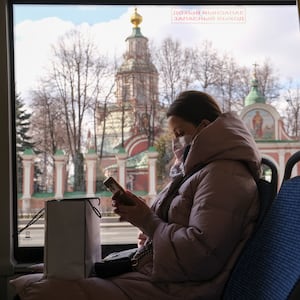BARCELONA—It was a perfect Barcelona day. The wet air was filled with spring smells. The city’s pollution rate had declined by 89 percent. Crime had dropped more than 70 percent. Police cars, lights flashing, sat idle on the empty street. The ambulances, around 10 of them, were parked in front of my local health center. One rode past, its lights on but with the siren silent.
A perfect day, except the COVID-19 death toll had just exceeded that of China, a country of 1.4 billion.
Spain is reeling from the coronavirus epidemic. By Friday, the daily death toll reached 769 over 24 hours. As of this writing, Spain has suffered 4,858 fatalities overall with 64,059 confirmed cases—including 9,444 health workers. Some 36,293 people are hospitalized. Only 9,357 patients have recovered. All this in a county with a population one-seventh the size of the United States.
The mood in this context of looming mortality is surreal. The virus is invisible, death omnipresent and the silent streets speak to an almost ghostly existence.
The only reasonably good news was that Thursday saw only a 14 percent increase in cases compared with 18 percent a day earlier and 20 percent on Wednesday.
Across the country, the army has been deployed to deep-clean hospitals and other facilities—including some 900 nursing homes where at least 1,517 deaths have been recorded. Members of the Military Emergencies Unit found corpses, including “some totally abandoned elderly people—even some who were dead in their beds,” Defense Minister Margarita Robles told the Ana Rosa TV program.
Nearly two weeks into a general quarantine that the government says will last at least until April 12, and it is hard to remember a time when people rubbed shoulders, drinking and dancing in the ciudad condal. Now, the time of revelry feels like a distant era. To be sure there are the nightly 8 p.m. cheers for health workers on the front lines of the crisis. And on a Friday night clutches of young people put out disco lights and dance on their balconies. The spectacle lasts for maybe 10 minutes before they go back inside and shutter their doors.
How did it all go so wrong so quickly?
While China was busy fighting the virus, warnings about the critical importance of being prepared for what was coming went largely unheeded. “Perhaps stopping the entry of the virus was impossible, because it involved confining a country without [visible] cases,” wrote a Spanish researcher, a consultant physician in internal medicine and infectious diseases, in an opinion piece in the Spanish daily El Periodico. “But we could have bought equipment and designed protocols that would not put our health workers in the battle that they are currently fighting piecemeal and without adequate weapons.”
Even when the disease had arrived at Spain’s doorstep there was a feeling of business as usual. In a country where the elderly often pick up their grandchildren, schools didn’t close until just before a national emergency was declared. Airports didn’t bother to screen passengers for signs of fever. The week before, on March 8, a huge march celebrating International Women’s Day was allowed to take place, despite the obvious danger.
An unprecedented number of Spain’s politicians began to fall ill. Every ideological faction was hit, and right at the top.
Spain’s Minister of Equality Irene Montero, who attended the rally, tested positive, as did Isabel Díaz Ayuso, president of the Community of Madrid. Meanwhile Santiago Abascal, leader of the ultra right-wing Vox Party, along with Javier Ortega Smith, the party’s secretary general, fell ill with the disease. So did Quim Torra, a leader in Catalonia’s independence movement. Even Maria Begoña Gómez, the wife of Spanish Prime Minister Pedro Sánchez, was stricken.
Throughout the country, but particularly in the Spanish capital of Madrid, the dead began to pile up. On Wednesday, reports surfaced that a new residence for the elderly in the posh district of Chamartin had been decimated by the virus. Some 25 people at the facility had perished, and 50 were infected. Management called the military for help as the silent plague raged around them.
The virus has spread quickly to the countryside as well. In addition to Madrid, the Basque Country and Catalonia, the disease has reached Castilla y León, Castilla-La Mancha, and Valencia. Major hospitals as far as Murcia and Andalucia reportedly are inundated by coronavirus patients.
To be sure, both Spanish authorities and citizens generally are doing whatever they can to combat the onslaught of disease and death. In Madrid the military has been hard at work trying to create extra capacity for the overflow of patients from hospitals struggling to keep up with an exhausting caseload.
On Wednesday, more than 300 coronavirus patients were transferred to Pavilion 5 at the Madrid exhibition center, where scores of beds with oxygen tanks had been installed. A small laboratory was built to analyze patient data, and radiology equipment was brought in largely for chest X-rays. The hope is that an intensive care unit consisting of some 96 beds will be ready by Saturday. “Our role is to unclog all the hospitals in the region,” said Eduardo López Puertas, the director general of Ifema, which manages the complex.
Meanwhile, citizens played their part. Unlike in Los Angeles, where there are reports that businesses refused to close after a general quarantine was declared, Spaniards throughout the country cooperated as best they could. Faced with a shortage of medical supplies, people brought out their sewing machines and stitched together makeshift masks, which were donated to the elderly. Soup kitchens for the poor and the vulnerable began to emerge.
In the United States, supermarkets were scenes of much-publicized chaos and disrespect for social distancing, but in Barcelona and elsewhere, people gently lined up two meters apart, giving the elderly and the vulnerable preference. In Barcelona and other cities, some even took the time to make sure the city’s pigeons had enough feed to survive the plague. In the absence of humanity, rats braved some streets as never before. A wild boar was even reported rummaging for food in the city center.
When the elderly, living alone and vulnerable, decided to go outside, normal people at newspaper kiosks and on street corners told them to stay in doors. Better loneliness than death, they urged. And while the police fined some for being outdoors, their response with the vulnerable was generally more an expression of concern than anything else.
Still the number of intensive care beds, only some 5,000 spread throughout the country, did not nearly match the number who needed them. At the Severo Ochoa Hospital in Leganes, on the outskirts of Madrid, there were more than 260 patients in an emergency room with a capacity of 90.
Medical professionals throughout the country had to begin to prioritize who would receive precious oxygen and artificial respiration machines. Patients lay on floors or sat in plastic chairs.
Whatever could go wrong went wrong.
On Thursday it was learned that fast coronavirus tests that government officials had purchased from a Chinese supplier were essentially garbage. The tests manufactured by a Chinese company were supposed to have a sensitivity level of 80 percent when in fact the level of sensitivity was 30 percent. The tests are to be returned.
The lack of molecular testing kits means that the overall number of dead may be underreported in some parts of the country by as much as 70 percent, according to research conducted by the Institute of Health Juan Carlos III that was published in Spain’s El Pais newspaper. The institute cited abnormally high overall death rates in hard hit parts of the country, even taking into account coronavirus mortalities.
On Wednesday, associations of physicians, pharmacists, nurses, dentists and veterinarians representing some 721,000 medical professionals issued a joint statement in which they warned of a health care system on the verge of total collapse. “Health-care professionals find ourselves in a situation of total insecurity and helplessness,” due to the lack of basic supplies, the statement said. Already, as of Wednesday, some 14 percent of the infected were medical professionals.
A large hospital can use as many as 5,000 surgical masks per day. Now, at some facilities, hospital workers were jerry-rigging their own equipment including protective pants made from plastic garbage bags. On social media some doctors were touting the use of adapted one-piece diving masks as a protective measure. Workers caring for the elderly clamored for protective equipment, but to no avail.
Yet as absolutely frightening as this situation is, virtually no one I know would trade enduring coronavirus in Spain with having to face it in New York, Los Angeles or Seattle, where quarantines and school closures weren’t enacted until the very last minute.
It is unbelievable to think that there are places that could be worse than Spain right now. But the overwhelming fear for those of us who care about America—and there are many here—is that the United States will endure an even greater catastrophe than we have seen.
The new reality is that the virus creeps silently among us, eroding and in many cases destroying whatever sense of safety we had even a month ago. Cooped up in their apartments, people hear the sirens of passing ambulances riding along empty streets. They peek from the windows when the health workers stop to pick up another victim. The disease has become a neighbor.







